#mohair pieces
Explore tagged Tumblr posts
Text
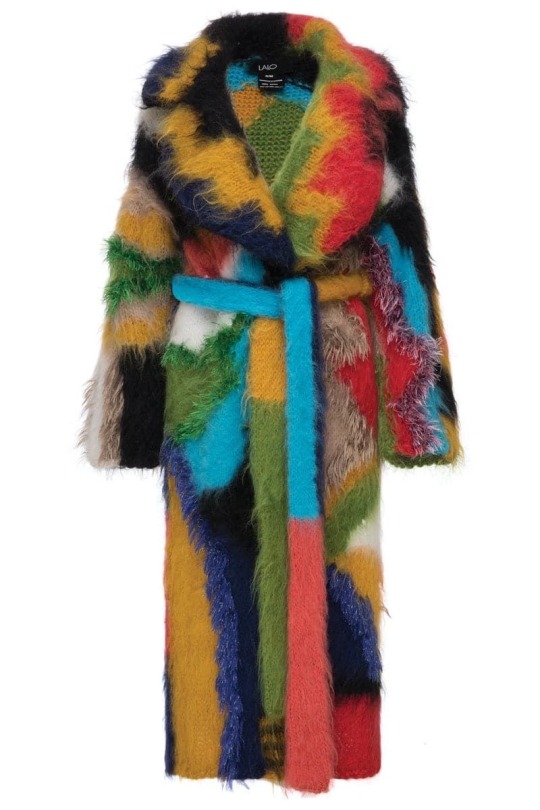
CULT MIA — Belted Mohair Trench Coat
#runway fashion#cult mia#high fashion#editorial#mohair#2024 fashion#new generation#chet lo#faux fur#mohair pieces
45 notes
·
View notes
Text
instagram
#sasha gymn#art#makeup#performance#cinema#movie#Instagram#THE CHROMATIC TEMPEST 🏔#Conceived#performed#by @sasha_gymn#With beauty direction and music#Featuring products from @shiseido @narsissist and Chanel.#This performance is a symphony of words#colors#music#and movement—a storm transitioning from slow to fast#fear to purple#pink to a smile#from a rainbow to a dance#from shout to astonishment#and from movement to black stillness.#Sasha Gymn stuns in pieces by Valentino#La Perla#Thomass#a Ukrainian dress#and a mohair Sisley piece.#Lipstick#blush#and eyeshadow seen in this performance are integral parts of Sasha’s beauty expression.
0 notes
Text




〰️GHOST DAWG〰️
Mohair and reflective cord. 5x7 inches. My piece for @dedmalcollective ‘s Animal Parade show opening 2/15/25 at @sonnyshouseof . I am obsessed with this reflective cord I bought at @fiberrhythm . It’s better in person! Thank you for the invite @sixgills and thank you @folklaurel for organizing this! 〰️〰️〰️〰️〰️〰️〰️
140 notes
·
View notes
Text
Sebastian Stan Appreciates Taking Things 'A Little Less Seriously'
The actor caught up with L'OFFICIEL at the CFDA Fashion Awards to discuss wearing Thom Browne and his transformative roles in A Different Man and The Apprentice.
by Carrie Wittmer

Sebastian Stan in Thom Browne for the CFDA Awards 2024
Photography: Ryan Lowry Stylist: Michael Fisher Grooming: Amy Komorowski
On camera and off, Sebastian Stan is always aware of what he is wearing, whether he's suited up as the Winter Soldier in Captain America or sporting jeans and a T-shirt on a day off. The actor— who stars in and is winning over buzz for his transformative performances in A Different Man and The Apprentice—represented Thom Browne at the 2024 CFDA Fashion Awards on October 28 in New York City at the American Museum of Natural History. For the event, Stan wore a full Thom Browne look: a classic ticket pocket tuxedo with self-tipping in black, 3-ply mohair; a knit vest in black cashmere; a classic button-up shirt in white oxford; a necktie in black silk faille; and penny loafers in black patent leather.
In A Different Man, Stan plays an aspiring actor with neurofibromatosis who has facial reconstructive surgery that dramatically alters his appearance. In The Apprentice, Stan plays former President Donald Trump in a film that follows his rise to power, focusing on his mentor-mentee relationship with lawyer Roy Cohn, portrayed by Jeremy Strong from Succession. Stan received critical acclaim for his performances in both films, and is now a likely contender for the upcoming awards season.
At the CFDAs, Stan told L’OFFICIEL about his look for the night, his connection to Thom Browne, and how clothing and costumes impact his performances. Read on for the interview.
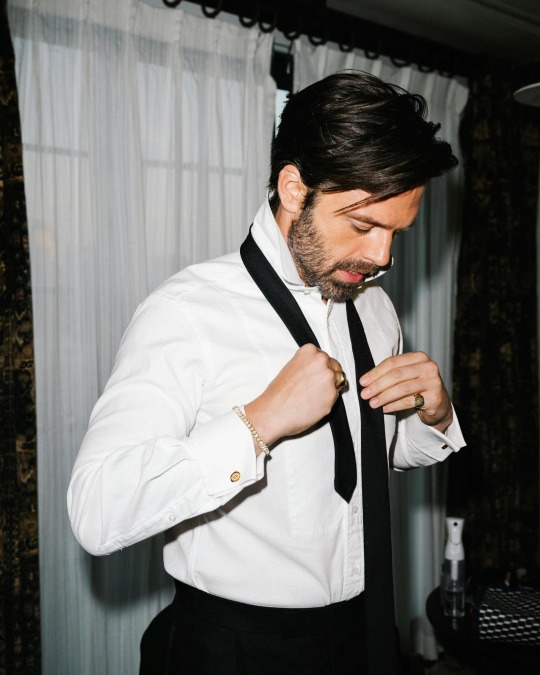
Sebastian Stan in Thom Browne for the CFDA Awards 2024

Sebastian Stan in Thom Browne for the CFDA Awards 2024
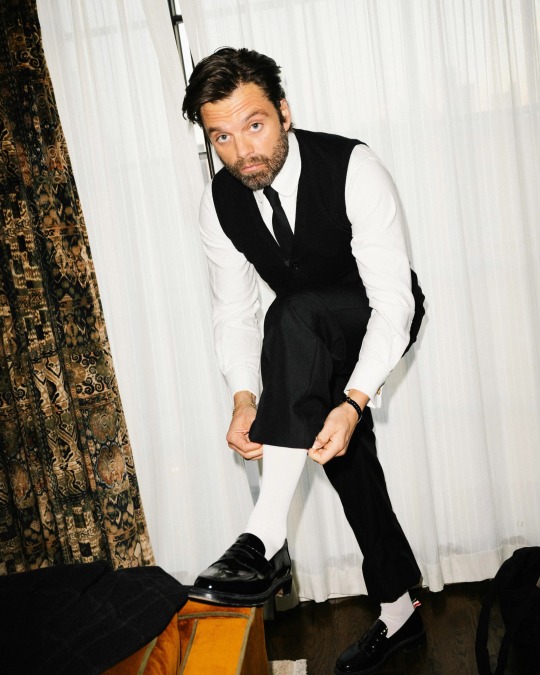
Sebastian Stan in Thom Browne for the CFDA Awards 2024
L’O: Tell me about your look for the CFDA awards.
Sebastian Stan: Thom Browne’s take on black tie-not traditional, polished in a new way and comfortable while being structured. I appreciate taking things a little less seriously, especially during awards season. I love my straight tie and knit vest—less serious, but certainly not less appropriate.
L'O: How would you describe your off-duty style? What do you wear on a day off?
SS: Jeans and a tee shirt.
L’O: What character that you’ve played is most likely to wear Thom Browne?
SS: Carter Baizen would wear the hell out of a Thom Browne suit.

Sebastian Stan in Thom Browne for the CFDA Awards 2024

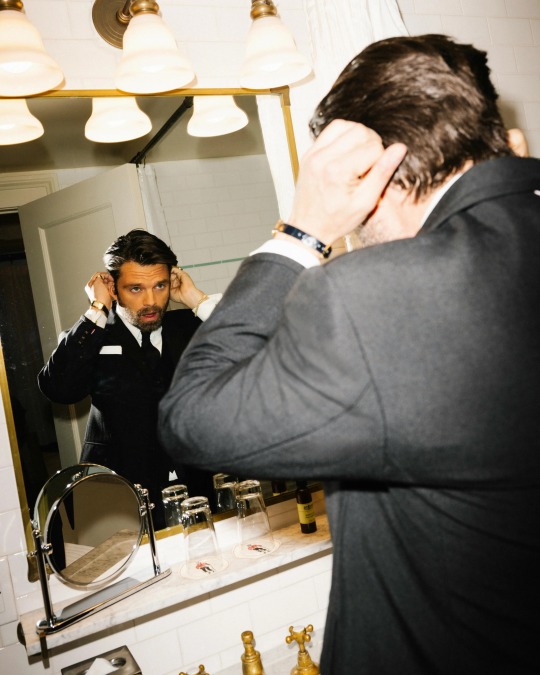

Sebastian Stan in Thom Browne for the CFDA Awards 2024
L’O: Your roles in A Different Man and The Apprentice are very physical performances... and so is Bucky Barnes. How do you approach creating a character’s physicality?
SS: It all actually starts from the inside out. Muscles have memory. We wear our pains, our pride, our truth: the ones we project and the ones we keep hidden from the world. It all depends on what’s driving somebody…The need for love, the need to be heard, the need to prove, the need to hide, etc. Everything influences how you move and you walk. Obviously when you’re playing real people the clues are already there to study. Like an instrument. With something like A Different Man, there’s a backstory and the prosthetics influenced everything. Similar with Bucky Barnes. His past is always in his body.
L’O: How do clothes and costumes enhance your performance?
SS: I love costumes because they speak for themselves. When you walk in a room immediately people look at you and what you’re wearing tells a story. The choices one makes in terms of portraying themselves to the world are very revealing. So costumes are a big piece of the character before any words are even said. They also influence the way you walk. I’m particular about shoes. What kind of shoes a character wears. Sneakers make you walk a certain way boots a totally different way. Maybe you stand up taller as a result and so on. Same with clothes. A suit affects everything. So does a pair of jeans you’ve lived in for a decade.

Sebastian Stan in Thom Browne for the CFDA Awards 2024

Sebastian Stan in Thom Browne for the CFDA Awards 2024
#Sebastian Stan#L’officiel#L'OFFICIEL#L'OFFICIEL Magazine#Photoshoot#mrs-stans#Awards#CFDA Awards#CFDA
73 notes
·
View notes
Text
Fibers in Fiction - A Silmarillion Writer’s Guide to Þerindë's Craft
It's the @silmarillionwritersguild's Meta Week, and I wanted to contribute my two special interests -- fiber art and Tolkien -- and my real world degree in Medieval European Women's History. So here's a essay with writing resources for Day 6 - apply real-world disciplines to Middle-earth.
Most of this I had sitting in the back of my head and do not have quality, academic sources for. Links are either to written or video resources, or to picture credits.
Intro
What is fiber art? My personal definition is the manipulation of some sort of fiber into something functional and/or beautiful. There are a few characters in Tolkien’s works that are associated with a fiber craft of some sort – Vairë the Weaver, Míriel Þerindë, and Arwen Undómiel come to mind the easiest. I've seen various fanworks that have Caranthir also be a needle-worker, but that's not canon the way these three women are. There's a lot to be said about the intersection between "women's work" and needlework and feminism, and Tolkien's inclusion of those patriarchal standards, but ... that's not this essay.
There’s a lot of methods and a lot of disciplines that can be put under the umbrella of fiber art. The purpose of this essay is to help fic writers expound on the process of a fiber craft using the correct terminology, gain an understanding of period(ish) appropriate tools/techniques, and the differences between some of the major forms of fiber arts.
What is a fiber?
Starting with the basics. A fiber is a material that is longer than it is wide and typically used in textiles or electronics. This is Tolkien’s world, we’re not worrying about electronics, so let’s turn to textile fibers. There are four main types of textile fibers:
natural fibers - flax, hemp, cotton, jute
animal fibers - silk, wool, catgut (not made from cats), angora rabbit fur, goat hair (mohair, cashmere)
synthetic fibers. - polyester, acrylic, nylon, rayon
Metallic fibers - gold, silver, copper, mithril that have been formed into a very thin wire
Obviously, unless the Valar let Fëanor get into oil extraction, all those synthetic fibers are right out. Leatherwork does not count as a fiber art, since true leather is a processed animal skin. Cords can be cut from leather to act like string, but that’s not a true fiber. And don’t talk to me about pleather or vegan leather. That’s just plastic and it’s bad for the environment.
Spin a Thread, Draw a Wire
For the three types of fiber that could be used in Arda, there are two methods to turn these materials into thread: drawing and spinning.
Drawing a wire: a small piece of metal is pulled through a device called a draw plate. A draw plate may have many holes through which the wire is pulled, each getting successively smaller and smaller until you reach the gauge (size) you desire. As you pull the wire through each smaller hole, the wire gets thinner and longer. Rinse and repeat until you have a wire of the desired thickness. If you’re combining a wire with some sort of flexible fiber (couching, weaving, etc, see below) it needs to be extremely thin in order to be flexible enough to bend with the fiber it’s attached to.
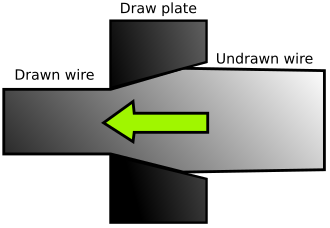
You need a lubricant to ensure the wire doesn’t get stuck in the draw plate. Covering the wire in oil is a good way to go (this is called dry drawing. Wet drawing is when the draw plate and the wire are both submerged in oil as you work). Application of heat can make this process easier, but depending on the metal, you might not need very much.
Gold, silver, and copper are all very soft metals in their purest form -- alloys will make them stronger, less malleable, and harder to draw. Mithril, given that it’s a fictional metal, I can’t confidently comment on, but it’s said to have been very malleable, so I would imagine that the same process for creating very thin wires would also work in the same way as it would for the other metals listed.
A spun thread is an assortment of individual fibers that have been twisted together to make a stronger unit. Natural, animal, and synthetic fibers can all be spun.
Usually when we describe something as a thread, we’re talking about a spun fiber that is fine/thin and smooth enough for sewing or weaving applications. Spinning a thread involves taking a pile of washed and combed but loose fibers (a bundle of these is called a roving) and literally twisting it until it forms a thread. This can be done with a drop spindle or a spinning wheel. A drop spindle is the more mobile form of spinning, and simple enough that medieval families would often have children spin. With practice you could even do it while walking. Imagine, for a moment, Míriel Þerindë walking through Beleriand during the Great Journey, drop spindle in hand, making the thread she is known for. That’s some good stuff. I’m begging somebody to write this.
Here’s some video tutorials on how to use a drop spindle and how to use a spinning wheel. I can’t explain it succinctly, and a visual is always a good tool.
Plyed Threads Make a Yarn
Yarn is several threads counter-twisted around each other. Counter twisting is what holds the yarn’s structure. If the individual thread is twisted clockwise, the yarn must twist all those clockwise threads counterclockwise. The tension holds the shape of the yarn.

Yarns (usually made from an animal fiber like wool, goat, or angora) and twines (usually made from natural fibers like hemp or jute or cotton) are made the same way because they make the threads stronger and more durable than they would be as individual threads, but their material usually dictates how they’re used. Yarns are softer, better for knitting or crochet or weaving. Twines and cords tend to be rougher, better for securing things to other things, for outdoor use, or … you know. The things they do in Angband.
Weaving a fabric
So you’ve got your thread and/or yarn. Now what? Well, you can dye it now (see next section), you can start knitting a garment (you need good socks on the Helcaraxë), or you can start weaving a fabric. Fabric has two components, both made by individual threads in sequence. The warp is generally static, and the vertical thread in most diagrams, including the ones I’m including here. The weft is the thread that passes back and forth horizontally. You can have the weft go over/under/over/under like this diagram (this is called a plain weave) or you can have the weft skip over a number of warp threads to create a pattern or a texture (satin or twill or denim weaves skip warp threads). The pattern depends on which warp threads get lifted or lowered with each pass of the weft, which is typically attached to a shuttle that glides through the shed.

Weaving requires a loom, but that loom can come in various form-factors. A backstrap loom maintains tension in the warp by the position of the weaver, who has a strap attached to the loom going around her back while she manipulates the weft in front of her. This was, and still is, commonly used in native South American communities.

Early medieval Europe typically used a warp-weighted loom, where the warp threads were tied to a loom weight that dangled off the back of the loom frame. This was replaced later with the horizontal loom, which included the invention of heddles (loops that lifted warp threads in sequence to make a shed (opening) so as to make a pattern) and treadles (foot pedals that control the heddles).
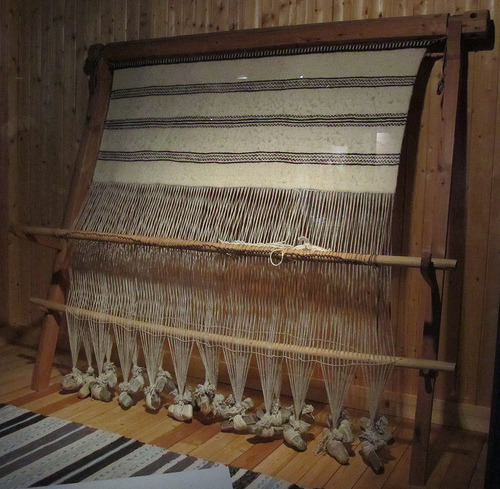
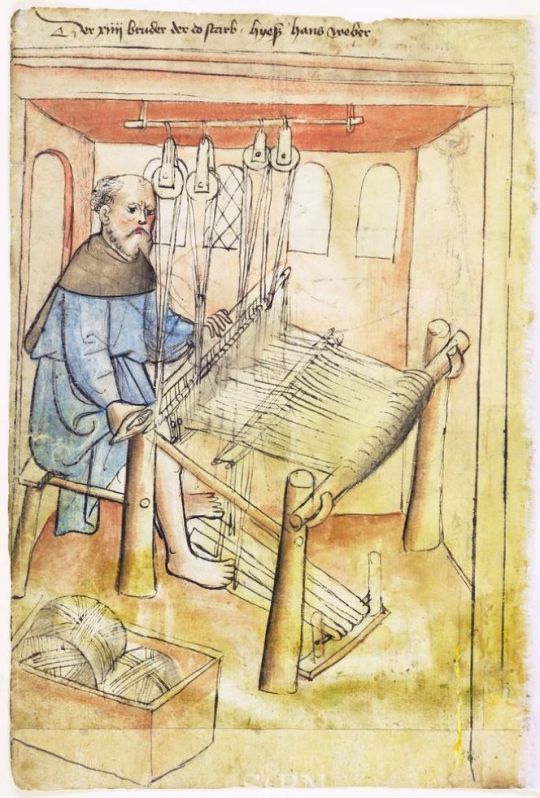
Later, the horizontal loom gets mechanized, and somehow we got computer programs out of Jacquard looms. Fascinating, but not relevant here.
One of my favorite types of weaving is tablet weaving, which instead of heddles or treadles to form the shed, uses square cards. Four threads go through the corners of the cards to form alternating sheds that can form complex patterns. Tablet weaving is great for decorative trim and edges. You can use a backstrap method, a warp weighted method, or an inkle loom to create tablet woven articles. This video is a gorgeous introduction, but a bit long.
What about Vairë’s tapestries, I hear you cry out into the Void? See below :)
Add a splash of color, become ungovernable
Color! The world can create rainbows, and we’ve been trying to make thread to match for ages. Luckily you can make most colors with natural dyes. Purple is the hardest color to get with a natural dye, along with blacks; yellows and reds and browns are easiest.
You have to prepare your dye (usually taking some natural material (onion, cochineal insects, gallnuts, walnuts, marigold flowers, woad, madder, whatever you have) and your thread/yarn/fabric separately before combining them with heat.
Prepping your dye depends on the material you’re using. Sometimes it’s just an overnight soak in a pot, sometimes it’s crushing beetle carcasses into a fine powder, sometimes it’s boiling. I leave it to you, friend, to research the exact color you’re looking to make with a natural dye and how to get that, but this chart might be a good start.

Most thread/yarn/fabric needs a mordant. Mordant is a dye fixative. After all that work making the fabric, you don’t want that gorgeous Fëanorian red (madder root) to come out in the wash water, right? Mordants are acids that can be found naturally, either by processing some plant materials to create tannic acid (oak trees and oak galls) or oxalic acid (wood sorrels), or by working a chemical process using alum, chrome alum, or sodium chloride, or ammonia (stale urine was commonly used before modern chemical processes). Mordants stink to Angband and back, so historically dyers would be outside town or in their own district as to not offend everyone elses noses.
You can get a richer, more saturated color by overdyeing – dying twice or even three times. Dyes are hard to color match; each batch is going to have its own variables (weather, temperature, concentration of the dye, concentration of the mordant, quality of the fiber, etc).
I’ve found this website that goes into a lot more detail. I’m not affiliated with them, but it’s a good starting point.
Tools
A non-exhaustive list of standard tools a fiber artist may use and material it could be/typically is made of:
Thread, yarn, or fabric (described above)
Scissors/shears (metal)
Sharp sewing needle in various sizes (bone or metal)
Blunt needle in various sizes (sometimes called a tapestry needle, bone or metal)
Spindle (wood)
Loom in various sizes (wood, wire, thread)
Shuttle (wood)
Knitting needles (bone, wood, or metal)
Nalbinding needle (bone, metal) (nalbinding is a cousin of knitting and crochet, good for hats and socks)
Crochet hook (bone, metal, wood)
Bobbin (wood, bone)
Lace pins (metal)
Lace pillow (fabric)
Embroidery hoop (wood)
Embroidery frame (scroll frame, slate frame, wood)
Embroidery stand (wood, metal)
Thimble (leather, metal)
Fiber Crafts seen in the Legendarium
Tapestry Weaving
Tapestry weaving is different than standard weaving, because the weft does not go across the entire length of the working area in a shuttle. Tapestry weaving typically uses many, many bobbins or needles of colored thread worked in a plain weave in small areas to make an image. In medieval Europe, tapestries would be used as a form of insulation, to keep the cold out, and as a status symbol. (All I’m saying is, give Himring more tapestries, and maybe the Ever-Cold fortress would be a bit more homey). Here’s this article from the Metropolitan Museum of Art about tapestries, and here’s a video about the making of large scale tapestries, which is the technique I imagine Vairë and Míriel use for the Halls.

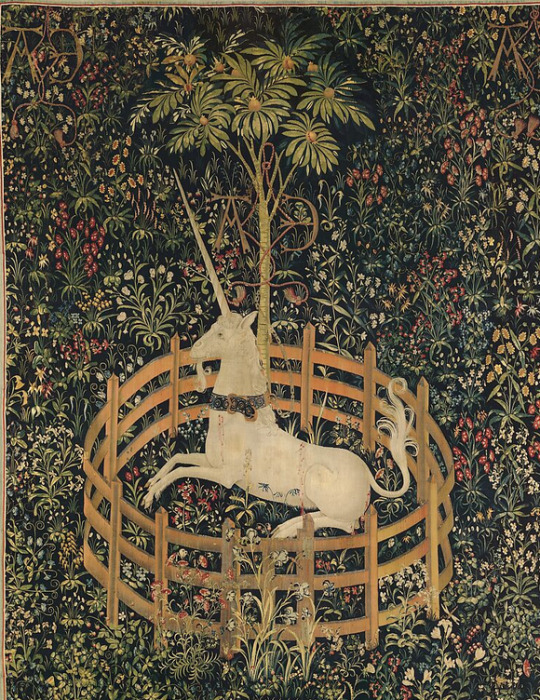
Embroidery
Embroidery is the practice of taking individual colored threads (usually cotton, wool, or silk) and sewing them into a ground fabric to decorate that fabric with a design of some sort. There’s SO MANY ways to embroider things. Cross stitch, which is what your author started out doing, uses stitched squares on a grid to effectively make pixel art with thread. You can do blackwork (which doesn’t necessarily need a black thread) which makes a repeating pattern on a grid but doesn’t make squares. Or there’s more freeform embroidery which lots of people use for natural scenes (flowers especially) but can be used for portraits, landscapes, silly sayings – the world is your oyster. The Royal School of Needlework in the UK has a Stitch Bank which documents how to accomplish many, many, many kinds of stitches.
I’m going to highlight a few stitches that absolutely should be in your writing toolkit if you are working with a character doing embroidery. I’m not going to describe every stitch, but knowing what a stitch is called is half the battle. Okay, maybe a quarter of it, you still have to either do it, or write a good description of doing it, which may be the other 3/4ths of the battle.
Satin Stitch - a good, all purpose filler. Made by stitching parallel lines of thread. Uses a lot of thread, since you should be bringing your needle up through the ground on the same side of the thing you’re trying to fill every time.
Couching - another good, all purpose filler. Made by laying thread or wire flat on the ground fabric, then taking another thread (close in color or not, depends on the vibe) and stitching it down in place securely. This is the main filling stitch in the Bayeux Tapestry (not a true tapestry, it’s just a really big embroidery) and undoubtedly how Arwen made part of Aragorn’s banner with mithril wire.
Straight stitch - makes a dashed line
Back stitch - makes a solid straight line
Stem stitch - makes a solid straight line that can easily curve
Chain stitch - good filler, makes interlocking loops
Daisy stitch - a chain stitch that doesn’t interlock the loops, but stitches down the loop so it doesn’t move. Makes good simple flowers
French knots - tiny filler, lots of good texture. Tiny knots made by wrapping the thread around your needle.
Stump work - 3D effects for ages. Want flowers or leaves to literally jump off the ground fabric? Stump work is your friend, and my personal nemesis.
Conclusion
Knowing the terminology of a craft is integral to learning more about it, and writing it accurately. My hope with this resource is that you might have learned a new term or two, or gotten a few new resources to use in your writing. Even better if this is something you don’t know a lot about, or have never given much thought to, then I hope you’ve learned something valuable here.
53 notes
·
View notes
Text
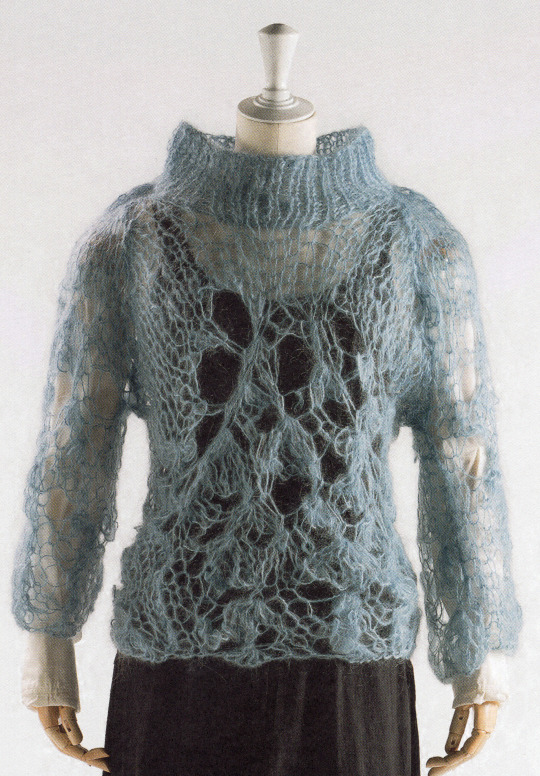
Maison Martin Margiela fall/winter (1990-1991) first lining washed cotton and shimmering viscose punk light-blue mohair sweater (1990)
Inspired by punk’s style, the sweater had uneven sIeeves and a relaxed funnel neck. Having no sweater manufacturer on hand, Margiela's mother did the knitting. With the help of some friends, she made 40 or so pieces in three different colors- light blue, deep red, and blacklight-blue mohair sweaterz. Instead of knitting needles they used broomsticks shaved down to size by his father to ensure that the stitches would be wide and uneven. The men's removable white poplin shirtsleeves -seen in the first collection-extended out from under the sweater's sleeves.
#maison martin margiela#maison margiela archive#fw90#fw91#punk#light blue#mohair#knit#sweater#textile#design#1990#1991#my scan
469 notes
·
View notes
Text
Jia Tolentino on Joan Didion’s “everywoman.com”
Joan Didion: one thinks of the Stingray, the mohair throw and the typewriter, bloodshed in Laurel Canyon, the decaying Summer of Love. It’s always a surprise to remember that the neurasthenic empress of American nonfiction once turned the terrifying gimlet of her attention to Y2K-era fan blogs and Kmart cake toppers for a defense of Martha Stewart. The peculiar liminal timing of the piece, which appeared in this magazine under the headline “everywoman.com,” is part of what makes it a singular artifact: it was published in 2000, three years before Stewart’s conviction for conspiracy and obstruction of justice and four years before Didion sat down to write “The Year of Magical Thinking,” a time when the Internet was new enough that Didion described one Web site’s “seductively logical links.” But the pairing—more accurately, a doubling—is unrepeatable: one mononymous perfectionist analyzing another, one carapace reflecting another’s gleam. Didion’s Stewart exegesis, in which most glosses of the subject could also apply to the author, is an ur-text on contemporary feminine ambition disguised only partially by style—on the will and the discipline, the persistence of misinterpretation, the unmentioned polestar of whiteness, the victory and the price.
The peg for Didion’s piece was the I.P.O. for Martha Stewart Living Omnimedia, which turned Stewart into a paper billionaire. At this point, Stewart’s empire included a syndicated newspaper column, a radio show, catalogues (eleven annual editions, fifteen million copies each!), two magazines, and enough home-and-party décor to carpet the tristate area. But the “only real product,” Didion wrote, was Stewart herself, idolized and mimicked by girls and women nationwide. A Web site called Gothic Martha Stewart advised goth teen-agers to learn from Stewart’s D.I.Y. resourcefulness. Online fan communities luxuriated in minute personal details: Stewart’s Suburban (chauffeured), her Jaguar (which she drove herself), her six cats, her four hours of sleep per night.
Presciently, Didion zeroed in on, and tacitly objected to, what we now call the parasocial. There is Stewart the real woman, with her ex-husband and daughter; on the fan sites, there are instead the “relative cases of ‘Martha’ and of ‘Andy’ and even of ‘Alexis.’ ” Although Didion had published that packing list in 1979, she was still some years away from her twenty-first-century transformation into “Joan,” a symbolic center of mainstream female identity and aspiration. By 2015, Didion had become consumer shorthand, her face appearing in a Celine ad and on the back of a twelve-hundred-dollar leather jacket. That same year, Martha Stewart Living Omnimedia sold for a fraction of its I.P.O. price. In “everywoman.com,” Didion had noted the “perils of totally identifying a brand with a single living and therefore vulnerable human being.” But what tanked M.S.L.O.’s stock price was not Stewart’s criminal conviction or her stint in prison as much as it was the rise of the Internet, which razed large swaths of traditional media and allowed innumerable proto-Marthas to become products themselves.
Success like Stewart’s—like Didion’s—always provokes outrage: the question of who this woman actually is versus who she’s pretending to be. The fuss around Stewart, Didion argued, was driven by the “misconception that she has somehow tricked her admirers into not noticing the ambition that brought her to their attention.” In Didion’s eyes, Stewart had “branded herself not as Superwoman but as Everywoman.” Stewart’s innovation was the idea that an Everywoman could in fact become Superwoman—and that, once she did, she should still pretend to be Everywoman, more or less. Around the time of the Didion Celine ad, we developed a name for this type of figure: the girlboss. And, soon enough, the Internet was overrun with Everywomen attempting to become Superwomen, then pretending, if they reached that echelon, to have been Everywomen all along.
Nearly all of the women who have tried to turn themselves into “Joan” or “Martha” have foregrounded an aura of effortlessness. Perhaps the dishonesty inherent in that project is why Stewart and Didion still reign symbolically supreme. Beneath the patrician breeze blowing through their self-generated iconography, neither Didion nor Stewart ever tried to hide the work, the clench of it, the teleological inclination toward the steely pristine. Didion ceded the best line in her piece to an anonymous Internet user, who wrote, about Stewart, in a summation that could be applied to both: “She seems perfect, but she’s not. She’s obsessed. She’s frantic. She’s a control freak beyond my wildest dreams. And that shows me two things: A) no one is perfect and B) there’s a price for everything.”
24 notes
·
View notes
Text
Joan Didion's Packing List:
TO PACK AND WEAR: 2 skirts 2 jerseys or leotards 1 pullover sweater 2 pair shoes stockings bra nightgown, robe, slippers cigarettes bourbon bag with: shampoo toothbrush and paste Basis soap, razor deodorant aspirin prescriptions Tampax face cream powder baby oil
TO CARRY: mohair throw typewriter 2 legal pads and pens files house key
“This is a list which was taped inside my closet door in Hollywood during those years when I was reporting more or less steadily. The list enabled me to pack, without thinking, for any piece I was likely to do. Notice the deliberate anonymity of costume: in a skirt, a leotard, and stockings, I could pass on either side of the culture. Notice the mohair throw for trunk-line flights (i.e. no blankets) and for the motel room in which the air conditioning could not be turned off. Notice the bourbon for the same motel room. Notice the typewriter for the airport, coming home: the idea was to turn in the Hertz car, check in, find an empty bench, and start typing the day’s notes.”
—Joan Didion, “The White Album” (1979)
#joan didion#the white album#literary#literary quotes#literature#literature quotes#writings#personal essay#slouching towards bethlehem#play it as it lays#the year of magical thinking#blue nights#novel#female author#writers#author#inspo#1960s#60s#60s icons#60s girl#1960s icons#writing#philosophy#essay#women writers#writers and poets#writer#book quote#book quotes
101 notes
·
View notes
Text
HUgE September 2011
Man in outer
Our signature drizzler, which uses no interlining and is stress-free to wear. This season, we have added a coin pocket inside the welt pocket and left welt pocket for added functionality. ¥93,450 (Pred PR)
The texture of the compressed mohair and the beautiful color scheme make for an elegant presence. It goes well with dressy styles such as shirts and trousers. ¥141,750 (Dries Van Noten Aoyama store)
A basic flight jacket with a wrinkled finish, giving it a symbolic look that is characteristic of Comme des Garcons Homme. Also available in navy. ¥82,950 (Comme des Garcons)

A design that mixes riders and MA-1. The knit details make it easy to move around in and comfortable to wear. The zip design around the neck is also a highlight. ¥81,900 (UNDERCOVERISM)

The delicate material of silk viscose is used to create a well-balanced, voluminous, oversized silhouette. A modern design typical of Damir Doma. ¥138,600 (CORONET)

The material used is tough duck, tweed, corduroy, and other materials used for each detail. Don't miss the buffalo check on the yoke. ¥70,350 (Comme des Garcons Junya Watanabe Man)

The trompe l'oeil design gives the impression of a layered look. This piece combines wildness and elegance, and can be coordinated coolly with slim pants. ¥228,900 (Third Culture)



The distinctive hem design is one of the details that symbolizes this collection, which is centered around layering. You can enjoy it in various styles by matching it with a vest or shirt. ¥165,900 (Pred PR)
#my scans#fashion#archive fashion#avantgarde#2010s fashion#japanese fashion#takahiro miyashita#takahiromiyashita the soloist#ann demeulemeester#givenchy#riccardo tisci#comme des garçons#junya watanabe#damir doma#undercover#jun takahashi#dries van noten#comme des garcons homme plus
27 notes
·
View notes
Note
What's your favorite type of yarn to have in garments to wear?
--
Wool.
If it's going to be right against skin, it probably needs to be superwash for the smoothness even though I dislike how the superwash process involves coating it with plastic and taking away some of the better qualities of wool.
I'm often too hot, so yarn often feels itchy to me. Wearing things more appropriate to the temperature helps a lot. I think some of my projects probably do need a little piece of linen or satin or something on the inside back collar or whatever place tends to rub though.
There are non-superwash wools I can wear against the sensitive skin of my neck. Some are particularly soft, but some are actually kind of tough. The key is that they're relatively smooth.
Hairy yarns like fucking mohair are the devil. Current trendy designers can take their 87 greige mohairs and shove them up their ass!
Alpaca tends to be hairy, but it doesn't always bother me. I have some lovely alpaca things I do wear a lot. I'm currently working with an out-of-production chenille that is an 80/20 rayon/wool (I'm assuming rayon fuzz and wool central thread). It's so nice to touch that it's hard to switch back to other projects. However, while it's a sensory delight, I have a feeling the garment won't look good for long.
I love many, many woven plant fiber textiles. I have not been impressed with plant fiber hand knits for the most part. Silk has a lovely feel but not enough stretch as a yarn for hand knitting. Yak, camel, etc. are fun, and I think I'd like them as much as wool if they were a standard type of yarn I could get here. I'll absolutely go for an exotic fiber if I come across one (nettle or someone's pet cat or whatever), but again, I don't use any of these often enough to pick them here.
Overall, a nice, squishy wool is what I want.
I need to get better at sewing because I'd like to wear more linen and ramie and such, but I want them to be woven fabrics, not hand knits.
32 notes
·
View notes
Text

Le Petit écho de la mode, no. 9, 1 mars 1896, Paris. 8. (1) Costume en drap amazone pain brûlé. (2) Costume en mohair glacé camaïeu. Ville de Paris / Bibliothèque Forney
(1) Costume en drap amazone pain brûlé. — Jupe â godets. Veste fantaisie â revers carrés. Chemisette-corsage en tissu pareil plissé. Manches d’une seule pièce. Ornements de piqûres et boutons métal.
(1) Suit in burnt bread amazon cloth. — Godet skirt. Fancy jacket with square lapels. Corsage blouse in similar pleated fabric. One-piece sleeves. Stitching ornaments and metal buttons.
Matériaux: 8 métrés tissu.
(2) Costume en mohair glacé camaïeu. — Jupe nouvelle, â 8 lés. Corsage ajusté garni d’un double pli creux et de pattes assujetties par des boutons. Ceinture ronde et col droit. Manches d’une seule couture.
(2) Suit in monochrome glossy mohair. — New skirt, 8 lengths. Fitted bodice trimmed with a double box pleat and tabs secured with buttons. Round belt and straight collar. Single-stitched sleeves.
Matériaux: 8 mètres tissu.
Employer la Fibre chamois pour les jupes et corsages.
#Le Petit écho de la mode#19th century#1890s#1896#on this day#March 1#periodical#fashion#fashion plate#description#Forney#dress#gigot#suit#collar
118 notes
·
View notes
Note
what do peterick each teach in this university lecturer au …. ?
this is a great and lovely question and i love you so much 👍 i would say patrick would be a constantly slightly wired music theory professor. i imagine that he’d come off as a little intimidating and strict, like he’d want to appear relatively professional and be as clearly good at his job as he can be, so i feel like he might be considered a little scary just by virtue of the fact that he’s mr professor guy, but if you catch him outside of class hours or email him for an extension and he’s totally the sweetest in lieu of pete’s ‘patrick looks like a teddy bear but really gets the fucking job done’. he’s mostly a lecturer but also does stuff with the school’s music societies (think conducting the college band and helping with the acapella group) i feel like he’s actively working on the most tedious sounding paper in the world but he’s SO excited about it and will take any opportunity to bring it up in conversation. i think he’d very rarely talk about his life outside of work because he’d like to ‘maintain a healthy work-life separation’ (plus he likes the drama of it) and thus he’s considered kind of an enigma. also pete bought him one of those ‘i have a phd (pretty huge dick)’ t shirts. he thinks he’s funny
pete would teach i think creative writing and he’d mostly do shorter workshops both for enrolled students and the wider local community (middle schools etc) focused more on getting people to enjoy the craft of writing something over doing it for a grade, but would still run regular traditional lectures and whatnot. he’d have a less traditionally professional professorial vibe than patrick, like he’d be wearing his big mohair cardigans and he’d be very forthcoming about his misguided youth in the hardcore scene and would frequently bring up and gush over his nameless partner. i imagine him being endearingly cringe in the how-do-you-do-fellow-kids manner and appearing a little frazzled and soft-spoken outside of his classes, because patrick has a significant leg up on him in the one-on-one conversation department. he’d always to an almost obnoxious degree be attempting to shill his bizarre novel but get bashful when it’s brought up to him <3
the way i imagine it being laid out as a piece of writing is focused on either a student who majors in some kind of music field and is taking one of pete’s shorter workshop classes as a supplemental credit because it looked fun, OR a relatively new co-worker of theirs. it’d take place over the course of around 3-4 months and primarily focus on this person’s ever so slightly unhealthy curiosity towards both the wider question of what patrick’s whole deal is outside of work and more specifically who on the faculty patrick is dating because he once made the mistake of letting slip that his partner worked at the same place as him <3 the conceit lies in the fact it’d be functionally completely unknown that they’re together amongst the student population and this would be maintained primarily through the fact that a) they seem very different in terms of their interests and behaviours b) they are rarely seen to interact because they teach mostly on different areas of campus c) patrick is crucially very private about his life and times d) pete despite otherwise being a total blabbermouth would refuse outright to speak on the subject because he loves and respects his special little man and e) 9/10 times it’s funnier to lie to people than it is to tell them the truth. so they’re functionally the pre-2019 dan and phil of chicago university lecturers
other facets of this universe include the fact that patrick has a bear pride flag sticker on his owala and his students struggle to discern whether or not he understands that it is in fact a pride flag sticker, and that pete keeps telling increasingly ambitious lies to his students about his life for the sake of his own sick entertainment. significantly, patrick won’t really be a singer: my vision for the backstory is that patrick did join pete and joe’s pop punk project but was too shy to do vocals and it fell apart after a few months but they all remained very close friends. i imagine that he does sing and does still have a beautiful voice, he’s just not really interested in doing anything with it 🫶
#i’m so glad you asked about this i had no idea i’d ruminated on it so much….#not sure which one of them would email like ‘okay 👍 when ever Sent from my iPhone’ but im open to input#pete has a very loud rattly lanyard setup. like hand sanitizer and shit clipped on there#unclear at present if joe and andy are going to be employed there too but i’ll play it by ear i guess#if anybody else is interested in picking up this idea in my stead i’d be more than happy 2 talk about them and all that 🫶 my special guys#concept heavily inspired by [email protected] by athenastits#and eddie kaspbrak office uncle extraordinaire by kyaticlikestea <3#peterick#asks
31 notes
·
View notes
Note
It’s the same anon again because the MCD beetles are slowly consuming my brain, but what are you thought on clothing culture in universe?
Like of course climate plays a big role in how traditional dress looks, but apart from that there’s also things like religion that play a big role. We don’t really know what the climate is like in Ru’aun but Irene is a big thing, how does that effect clothing choices, what dyes are most common and how does that reflect in clothes?
I’m a sucker for world building
Hello again, anon! Lucky for you I, too, am a sucker for worldbuilding. I have been considering my answer for literal days. I’ve vaguely commented on modesty rules in Ru’aun before but we’ve yet to get into fashion trends and hierarchical or religious dress, not to mention personal ornamentation and the different meanings associated with that in different areas, so let’s talk about Ru’aun first.
Because of the impassable Sacred Forest, most towns are along the coast to facilitate travel, and it’s a very lush and green region. The majority of the land is either plains or various forests, with a variety of cliffs, shoals and a few mountains scattered around, plus stretches of swampland and beach. Dyes are usually made from whatever resources are nearby, so you’ll see a much wider range of colors in settlements near flower fields or birch forests. Popular port towns like Meteli, O’khasis and Bright Port also have more variety, but will most often stick to colors that have special meanings to the town. Whites, greys, and blues are popular in O’khasis and Scaleswind as the religious capitals of the region, but red is also pretty prominent in Scalesind.
The same general rule also applies to fabrics and jewelry—mohair comes from goats so it’s easier to acquire in Phoenix Drop where there are tons, there’s more precious metals in Scaleswind, and in Nahakra people take any broken glass they find and lay the pieces in fine mesh containers on the tideline to make sea glass for decorations. Fabric and dye are common trading goods, especially in more backwater towns where the physical currency used in bigger villages and city-states have about as much practical value as an especially shiny rock. The most popular kinds of fabrics in Ru’aun are mohair and wool for their durability and temperature regulation respectively, with leather, ore and ivory as the most common materials in ornamentation.
The primary religion is what I’ve been calling the Divine Faith, which worships the Divine Warriors as a whole under the figurehead of Irene and has various subsets that focus more on each individual Divine Warrior, with the grand majority of its followers falling under the Church of the Matron or cults dedicated to the Destroyer, with the Trail of the Wanderer as a close second. Which of the Divine Warriors you follow most closely definitely has an effect on your attire.
Disciples of Irene wear small cloaks modeled after hers and members of the church hide their faces as a way to present themselves as closer to the goddess since you don’t look upon those of divine nature or close to divinity without consequences, most often using dark blue or white veils stitched with gold, since those are the colors she’s documented wearing most often and are therefore most often associated with her, though purple is too. Devout followers cover their eyes, members of the church like priests and nuns cover the lower half of their faces, and the High Priest covers his entire face, usually veiled or with a simple mask in public and with a more ceremonial mask during sermons and ceremonies.
Followers of the Destroyer are much more subtle because they’re technically outlawed, they have a lot more to do with ornamentation than clothing. If you have long hair, it’s always pinned up and back, never in a ponytail and never left loose, usually in braids and buns and other hairstyles that wouldn’t be out of place on a guard, nothing an enemy can easily yank on. Hanging jewelry is also out. Hair is adorned with warmly colored beads and hair sticks that can be used as weapons and on occasion chains are woven into braids, most other accessories are close-fitting: there are nearly always cuffs around the wrists and ankles, subtly decorated wraps around the waist are more common in cities, chokers with detailing done in texture are uncommon but widely used, and earrings and ear cuffs are rare and usually kept for formal ceremonies.
Those on the Trail of the Wanderer are nearly always found to be wearing travel-appropriate clothes no matter the occasion or setting, and there’s touches of pirate and backpacking aesthetic throughout. They tend to carry just about everything they own, dedicating their life to traveling and seeing the world the way Kul’zak did, and dress accordingly. Knee high boots, at least two layers, oil-treated cloaks, many wear jerkins and sashes with stitched depictions of scenes from places they’ve been, and leather harnesses and holsters are common. Hair is usually left down or half put up and decorated with feathers and ribbons found on the Trail. Meditation beads carved of wood or stone are nearly universal, worn around the neck or wrapped around the wrist. Trinkets and charms found on the Trail are important to the travelers, and you’ll find bowls of them left behind by others at shrines and trail markers that you can add to or take from, and in doing so you bring other travelers with you on your adventures and are carried by other travelers on their own, it’s a very dear tradition on the Wanderer’s Trail. Imagine geocaching but with religious connotations. Many of these items are worn as bracelets, anklets, necklaces, or on waist chains, usually put together while camping out. Flower crowns are also a bit of a thing and when they start wilting they’re left behind in places bearing Kul’zak’s symbol.
I’m thinking of making flower crowns also a thing with Enki’s followers since I’ve recently been turned onto the Kulki ship by @warlocks-and-phoenixes, but instead of wildflowers it’s mostly herbs and grasses. The matching flora crowns are a symbol of their union. Enki’s followers are mostly stuck on an iceberg, so they show their faith by carrying carvings of his symbols and making tapestries and records of their history, studying the world and spreading a love of knowledge wherever they go. Children usually start with embroidering their favorite/their family’s stories into their own clothing.
Embroidery! I love embroidery. In Ru’aun, it’s a very popular pastime, especially among stay at home parents and the sickly, so you see it pretty much everywhere. Colored threads are easy to acquire, but some colors are restricted. Purple is only for the clergy. Gold is for the highest ranking members of the churches and Lords’ family lines, as well as important personal staff of the Lord’s household like a close advisor and the primary caretaker of the children. Silver thread is for other people in powerful positions like members of a council or the highest ranking members of the guard (commander of the guard, second-in-command, reserve commander, Jury of Nine), which helps to distinguish officers from soldiers in larger villages and city-states that have a standard uniform and armor template. If you qualify for both, the gold usually takes precedence. For example, Laurance would have gold embroidery despite being head guard of Meteli because he’s also the son of Joh. Many small settlements don’t bother much with distinguishing personal importance based on thread color, though. They much prefer to use embroidery to keep a record of family history. Abstract depictions of personal achievements are stitched into the edging of most clothing, and the rank and position of the wearer and their parents + lovers go across the back on formal clothes and if you’re a guard around the neck and cuffs of your gambeson and also your sash if you wear one as a way to identify bodies after battle like modern day dog tags. It’s very simple and blocky on guardwear and incredibly elaborate and stylized to the point of illegibility on formalwear. Other common designs are flowers, symbols of faith, waves, landscapes, and elements of regional stories.
Modesty standards in Ru’aun. Here’s the basics: the average person should show nothing in the range of torso between the knees and breasts in public, midriff can be seen only by people very close to you, mothers should be covered from somewhere around the collarbones to their ankles, visible shoulder straps and undershirts are generally a no-no but off the shoulder and sleeveless attire are okay, and open shirts should not go further than the base of the sternum and should not show undergarments or nipples. Anyone fifteen or older is expected to follow these, but it’s not as important that children do. Some of them are negotiable based on climate and regional culture; Meteli and let’s say Pikoro are more lax and pretty much do whatever they feel like while O’khasis and Scaleswind follow the rules very closely and places like Brightport and Boboros are somewhere in the middle.
In Tu’la, how you dress is so important because it shows your loyalties. It’s a place filled with hundreds of clans all on the brink of beating each other up on any given day. In their culture, you’re not defined by who you are but who your family and their allegiances are. Symbology is important, families have their own color blends, patterns and even specific plants associated with them since gems aren’t very commonly found in Tu’la and sparkly things go to the monarchy and the king’s pets (the humanoid ones). Throwing away your clan’s symbols when you’re not on a covert mission of some kind is seen as a betrayal.
Cloth is very often uncut and styled by wrapping, pinning, and tying them into various shapes like you would a sari or toga or a variety of old African clothing styles I can’t remember the names of. Short sashes and waist wraps are very common. Many of the common people will also wrap their hands and feet in place of gloves and shoes. Cutting cloth is often reserved for important articles or the royal family and its vassal clans. It’s considered a wasteful expense since the excess cloth can’t be remade and isn’t recycled into other things like blankets. Scraps are distributed among the clan’s servants for them to wear to match their masters’ clothing as a sort of claim over them. Gladiators often wear their sponsor’s colors in the same way. When clothing is sewn, you’ll often see designs similar to the Japanese kimono and yukata and the Chinese hanfu and cheongsam/qipao. Designs with layers are more expensive and a luxury that very few, essentially only the king and his consorts, can afford. In most places, the only articles of clothing you’d find cut and stitched into new shapes are some forms of undergarments and a more form-fitting underlayer that covers the entire torso and cloth is arranged over top of.
Tu’lan clothing is essentially custom tailored by the wearer for the wearer, unless you’re super rich or a conscripted servant. Ideally it should allow you to be flexible, it should allow you to keep cool in Tu’la’s very warm climate, maybe with a window just above your butt if you have a tail, but easy to hide things in. Really the only rules about it is that you don’t wear enemy symbols and you keep your private parts private around everyone not your lover. It’s a war country, so most of the time the styles are very utilitarian and comfortable, but you’d only know how utilitarian it is if you were raised wearing them. To Ru’aun and Gal’ruk, even the simplest outfits seem fancy. Part of what makes them think that is the decoration and accessories.
Hair sticks. God do I love hairsticks. More formal ones are made of glass with a small hanging charm and common ones are simply carved from wood or made with the scrap metal shavings of weaponsmiths—those ones are usually sharpened into needles or knives in case you need it. Jewelry is usually close-fitting to make it harder to grab, so meditation beads would be wrapped several times around the wrist or ankle and no pretty hanging piercings. Humans are actually the only one of the three dominant species who get piercings because pretty much all meif’wa clans are warriors or their ears are too sensitive, and if a werewolf has to transform with a piercing in it’ll either warp super bad or hurt them when the change tries to push foreign bodies out of the werewolf. Cloth is usually made with patterns everywhere or very prominently displayed and accented.
Sun and snow motifs are also fairly widespread since the patron Divine Warrior of Tu’la was Menphia, it very rarely snows in Tu’la but she had ice powers so. Unfortunately, I don’t have anything more on Menphia’s followers right now, I’m basically scraping and redoing her whole temple and worship at the moment.
Gal’ruk loves yarn and fur, since practically every living thing out there is covered in fur and spinning yarn is a good time consuming indoor activity. A lot of people spend considerable time weaving and tanning and sewing over the blizzard season when they get trapped inside by storms. Fur goes inside everything from gloves to hoods to pants. People make competitions out of who can knit the best hat or scarf from scratch before the next moon.
For an idea of the style of clothing usually worn I recommend looking up ‘viking winter wear’ for some ideas. Plenty of layers, loose pants cinched at the knee, lots of fur cloaks and shawls, leather belts with pouches and space for your knife/sword/axe’s sheath over top. Leather goods like armor and belts are usually marked with subtle designs pressed into the materials and are padded. Nothing metal ever comes close to touching the skin directly. Clothes can either be simply pulled on or are closed with loops and clasps carved of wood or bone/teeth from a hunt.
Nothing hunted ever goes to waste. Gal’ruk is a plentiful land but it can be a harsh one too. Pelts, furs, teeth, claws, bones and tails are all made into clothing, among other things. Pelts can be scraped and tanned and made into leather, furs are stuffed into everything as an insulator. Teeth, claws and bones are carved into accessories or combs or buttons, it’s very common for someone to make the spoils of their hunt into necklaces or arm bands or earrings as a mark of their achievement or to exchange as a betrothal gift to prove their worth as a provider. Married couples wear carved tokens of their family’s symbol made by each other instead of rings, presented to the other for the first time at the wedding and very rarely taken off unless one dies or they get divorced. Widows and widowers usually keep their tokens old, but they’re burned to make the divorce official and if a divorced couple gets back together new ones have to be made.
Unfortunately color is fairly sparse on the island. There’s not many plants to harvest dyes from and clay takes ages to dig up and warm enough to use, so it’s mostly natural colors of the materials and some darker shades from smoking pelts over a fire to waterproof them. There are shades of green every so often from dye made with the kelp that washes ashore and sometimes if you can manage to grow beets there’s some reds and purples but not everyone is able to dye their clothing.
Gal’ruk has zero modesty standards. You wrap up to keep warm outside, but while you’re inside you can wear just about as little as you want. The public dining hall can get pretty warm with everyone packed in there, it’s not unusual for people to go titties out. They’re all warriors, they’re pretty chill about partial nudity and naked bodies are very rarely sexualized in such a close-knit warrior community, they’re all pretty much grown up seeing each other half undressed while tending wounds, so modesty isn’t a real issue. This is why I said in my post about Travis playing around with his shapeshifting that he needs to have Ru’aun modesty rules explained to him the first time he changes into a female form in public, because in his homeland having breasts show through an open shirt isn’t at all notable but in Ru’aun it’s absolutely scandalous.
And we’ve circled back to embroidery! Again, time consuming pastime, again, people who spend the majority of the year huddled inside waiting out the worst of the cold, again, followers of Enki. Personal history is recorded on parchment, but communal history is recorded on tapestries and clothing. They have very little in the way of colored threads, so designs are made with only lineart and shadows in mind to make it clear what they’re meant to be. Stories about Enki and the Divine Warriors are very common, and so are fables for the children. Animals bounding through the snow and their different tracks trailing behind them are used to teach the babies how to tell your prey apart by print. Kids are taught to embroider their own clothes to teach them patience and attention to detail.
These are all pretty general regional ideas, specific parts of the region and settlements also have their own deals sometimes. I’ll have to come back to this at some point to cover the rest of the Divine Faith properly. This was a fun question!
#minecraft diaries#mcd#aphmau minecraft diaries#mcd rewrite#dropofsunlightextras#aphblr#aphverse#aphmau mcd#worldbuilding#gal'ruk worldbuilding#tu'la worldbuilding#ru'aun worldbuilding#clothing#divine warriors#the divine warriors#irene the matron#shad the destroyer#kul'zak the wanderer#enki the keeper#menphia the fury#the divine faith#divine faith#kuri answers#kulki
40 notes
·
View notes
Text

FASHION CREDITS: LADY GAGA BY GRAY SORRENTI FOR ELLE'S FEBRUARY 2025 ISSUE
Lady Gaga is the cover star of Elle magazine's US February 2025 issue and will also cover the UK cover of March 2025.
On the special issues she discusses her upcoming seventh studio album "Mayhem" and her engagement to fiancé Michael.
Photography by Gray Sorrenti, styling by Pau Avia, hair by Akki Shirakawa, makeup by Frankie Boyd and nails by Miho Okawara.

For the cover shot, Gaga is wearing a full look from Valentino's Spring/Summer 2025 "Pavillon des Folies" collection, inspired by the fragility and transience of existence, exploring how beauty serves as both a remedy and revelation—an ephemeral yet profound anchor that brings meaning, solace, and connection amidst life‘s chaos and vulnerability.
Black organza blouse with voluminous ruffles, fully embellished in micro faux pearls, high-waisted tights with trompe l'œil panties.
The high-waisted tech knit shorts are from Fendi‘s Spring/Summer 2025 collection and her bra is the stylist's own.

A subtle yet beautiful accent to this ensemble was given with this divine teardrop pendant diamond necklace which hails from Tiffany &Co.'s Fall 2023 Blue Book: "Out of the Blue". Tiffany is the official sponsor of the jewelry for this editorial so you‘ll see much more with the next looks!
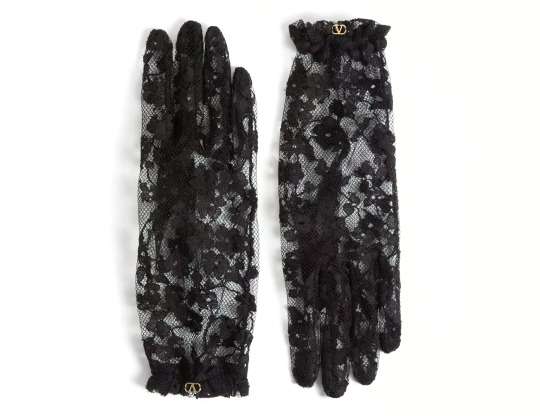
These Valentino VLogo signature lace gloves are made from floral lace and feature a ruffle trim along with the brand's logo as a small metal plaque ($690).

So good to see Gaga tap more and more into Dior again for her latest editorials. Here, she layered two pieces from the Spring/Summer 2025 collection to create a whole new look—metallic silver embroidered bodysuit with peek-a-boo side cut-outs and black silk moiré effect trench coat.
The black chiffon cape, she threw on top, is from Patrick McDowell's Spring/Summer 2025 collection.
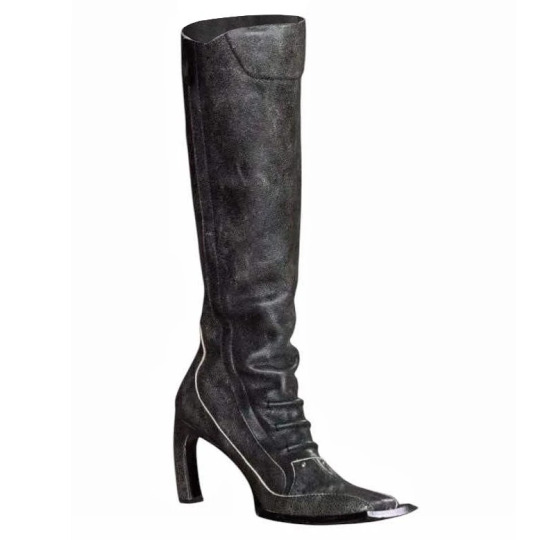
A very unusual yet fitting choice of footwear was provided by KNWLS who created these distressed grey leather biker-infused boots for her Spring/Summer 2025 collection.

Intertwined between her fingers and worn as a bracelet, Gaga wore this Tiffany & Co. Lock white-gold necklace ($1,100) throughout the shoot...

...just like, for several looks, she wore their Elsa Peretti collection Amapola brooch ($1,100), which means "Poppy" in Spanish. It is made of sterling silver and red silk.
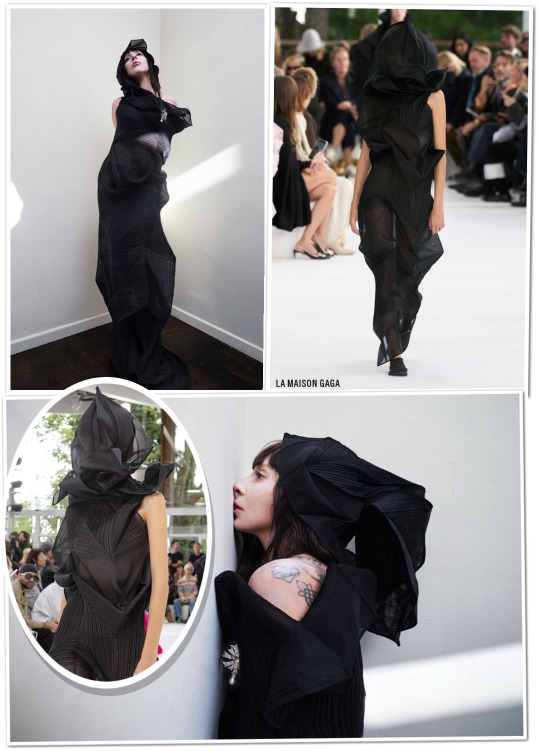
One of the more avant-garde and abstract looks is this Issey Miyake "The Beauty of Paper" Spring/Summer 2025 shaded black papyrus column dress with geometrical plissé panels (£1,265), and its matching hooded headpiece.
Drawing inspiration from washi, traditional Japanese paper, the designs embody the ethereal qualities of paper, evoking a sense of lightness and fluidity that is both calming and transformative. As models glided down the runway, it felt as though they were drifting through a dream—a world where the boundaries between fabric and paper beautifully blur.

The brooch, LG embellished her dress with, is the Tiffany & Co Ribbon Drop brooch from the "Birds on a Pearl" collection in platinum and 18k yellow-gold with a natural saltwater white drop pearl of over 16 carats and diamonds.

Don‘t have to explain how this is my favorite look of the shoot, do I?
Both Gaga‘s oversized and rhinestone-embroidered off-white feather coat...
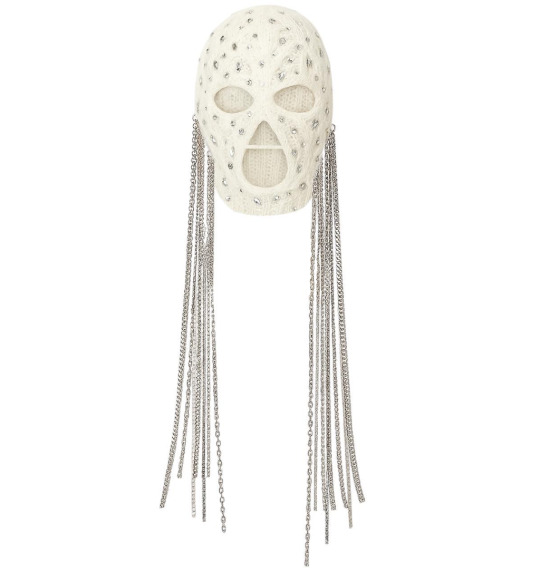
...and knit skull mask in ivory mohair with trailing silver metal and crystal chain banshee embroidery are from Alexander McQueen's Spring/Summer 2025 runway show, designed by Sean McGirr.
How amazing is it? Guys…has anybody met my Genie yet?
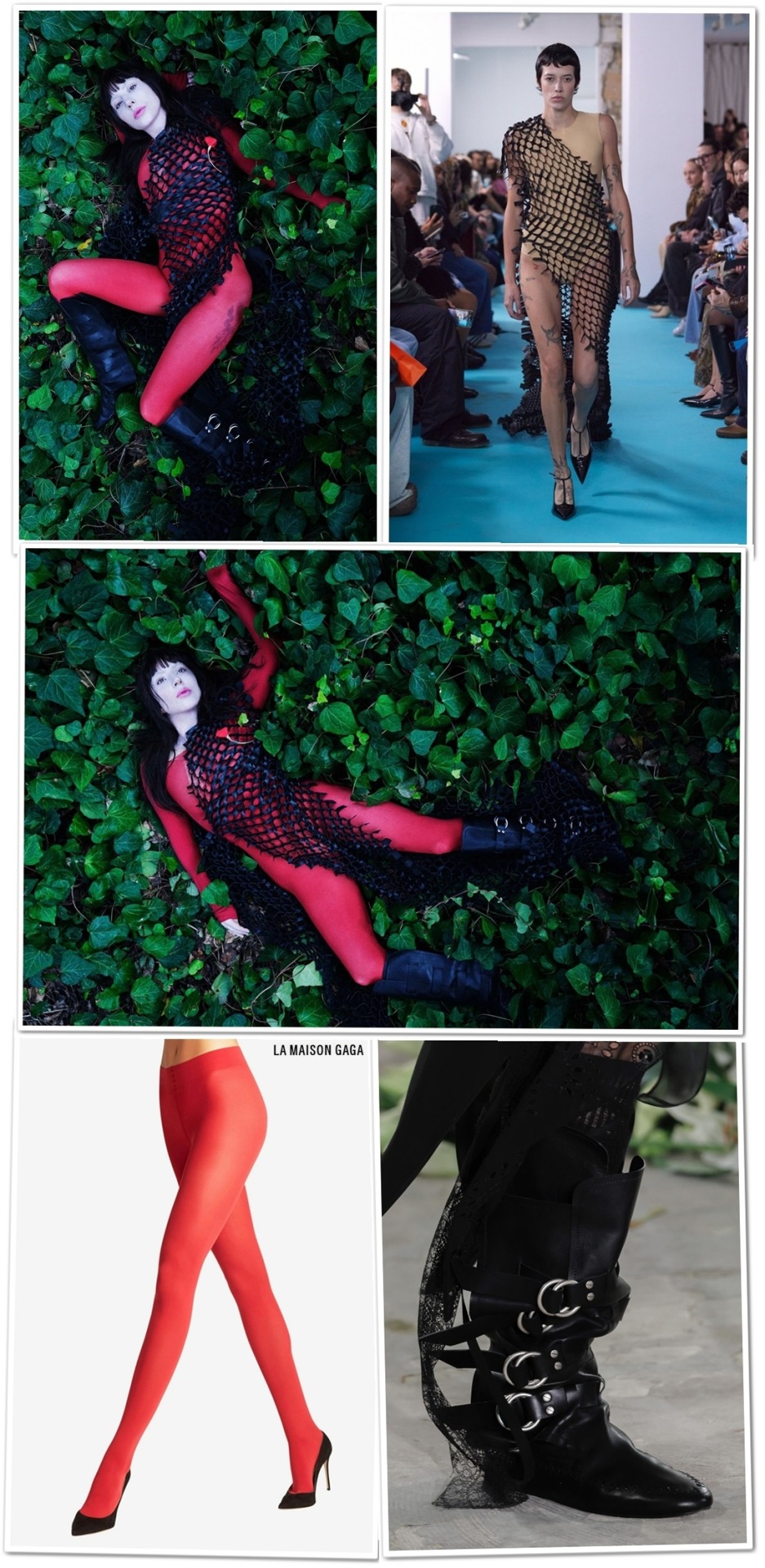
A couple of new labels also made it into this cover shoot! Here, LG lays down in nature while sporting a black leather fishnet dress with asymmetrical cut (£1,160) from ABRA‘s Spring/Summer 2025 collection which drew inspiration from 80s fitness calendars from Abra‘s parent’s‘ restaurant, fishing nets, shopping bags, and Spanish souvenir beach towels.
She added some layer and color by wearing these Falke 50 denier semi-opaque tights (£27) in "Scarlet" both as tights and as a top!
The look was completed with the aforementioned Tiffany & Co. Amapola poppy brooch ($1,100)...
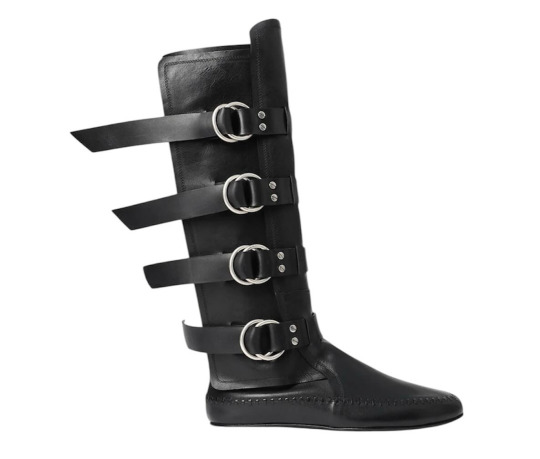
...and a pair of Ann Demeulemeester Spring/Summer 2025 Siver multi-layered O-ring bovine leather biker boots ($1,900) with leather stitching trimside wrap.

It‘s been always a little dream of mine to rock more pieces from the "Dark Lord of Fashion" aka. Rick Owens, so I‘m more than excited to see this Spring/Summer 2025 look appear in the editorial!
Scrunched and ruffled organza loofah-inspired jacket (£5,115), semi-sheer patchwork T-shirt (£455) and soccer-inspired nylon hi-lo shorts (£370).
The distressed porcelain doll-inspired nude tights are from Maison Margiela‘s latest artisanal collection, Spring/Summer 2024. You might remember her tapping into this collection with a whole custom look for her last Vogue editorial past year.
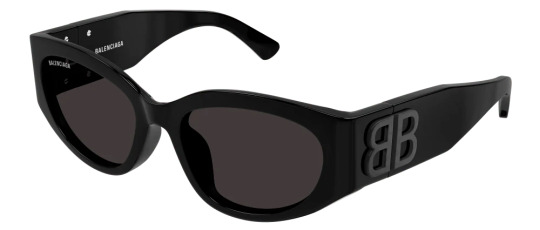
Next, the fashionista wears Balenciaga sunglasses. I highly believe it‘s these Spring/Summer 2025 Bossy AF eastman acetate renew (an acetate alternative partially made of bio-based and recycled content) shades with subtle-yet-not-so-subtle logo detail ($520).
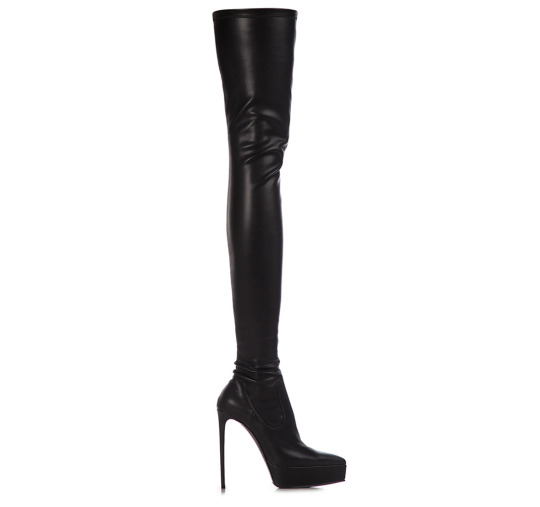
Gaga completed her dark yet sexy ensemble with these Le Silla Uma thigh-high black stretch leather platform boots featuring a pointed toe ($750).
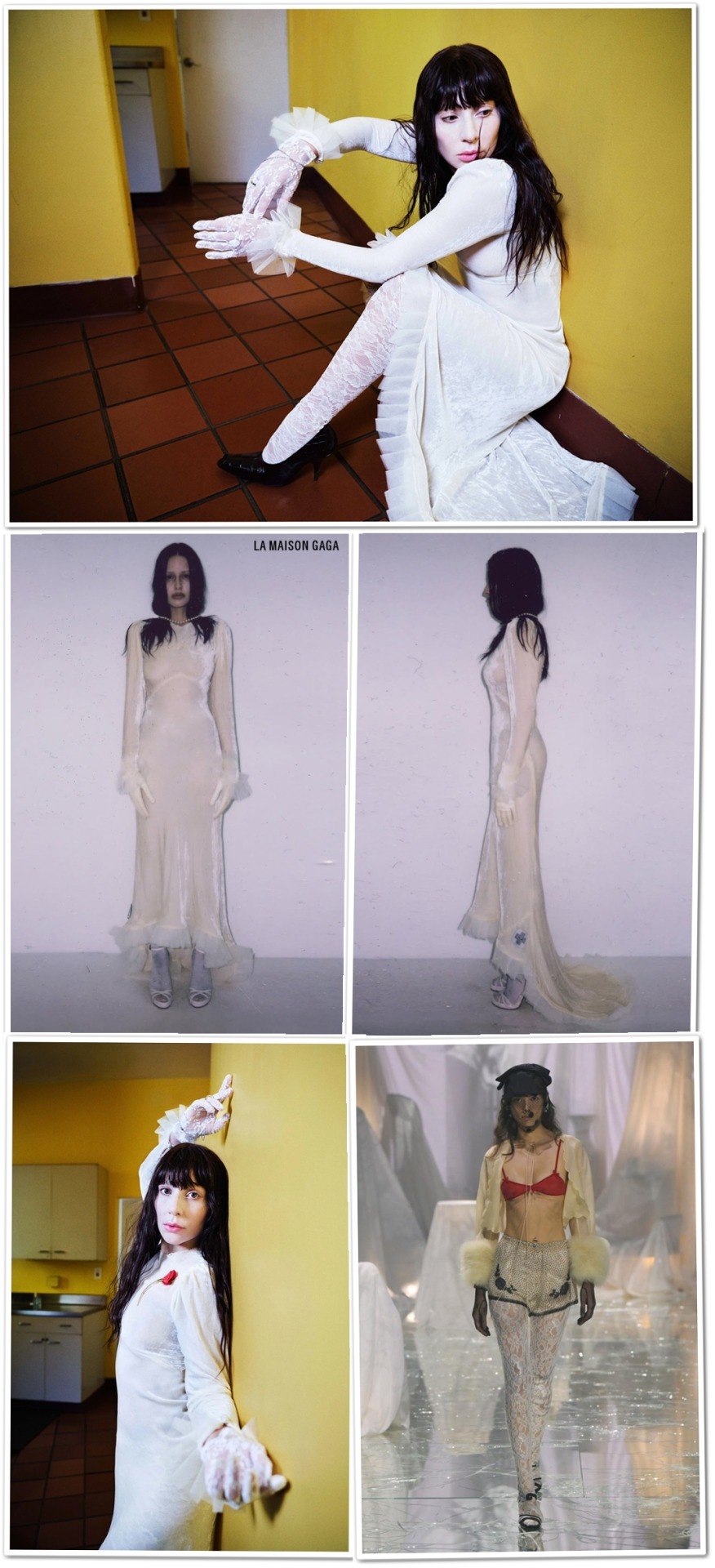
For our last look, Gaga brought something from her own closet. In Elle's video, she stated that ILONA is her designer to watch right now, because her dresses make her feel like a porcelain doll. And this one is definitely no exception!
Also from the designer‘s "Psychosis" collection, the Lotta dress is crafted out of antique ivory French silk velvet and features a pleated tulle trim and velvet-covered buttons.
Another Valentino Spring/Summer 2025 "Pavillon des Folies" pull are her white floral lace tights which perfectly blend in with her matching gloves by La Bagagerie.
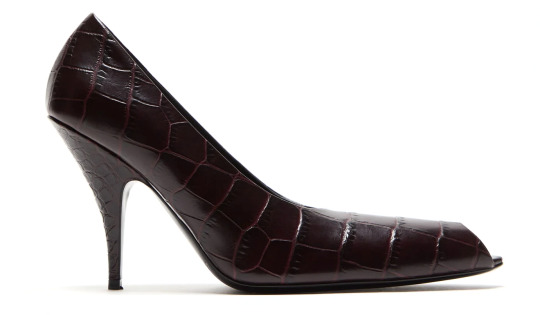
Last but not least, she wore the Acne Studios Spring/Summer 2025 croc-embossed leather elongated open-toe pumps in "Chocolate" ($950), which she previously wore in grey!
#November 2024#Tiffany and Co#Valentino#Acne Studios#La Bagagerie#Dior#KNWLS#ABRA#Falke#Le Silla#Calzedonia#Alexander McQueen#Issey Miyake#Fendi#Rick Owens#Maison Margiela#Balenciaga#Ann Demeulemeester#Patrick McDowell
12 notes
·
View notes
Text

US Vogue August 15, 1954
Mary Jane Russell wears a two-piece button-back dress in black and white Rodier wool-mohair tweed with a piqué collar, ribbon streamers. By Harvey Berin. Black and white tweed handbag, by Coronet. White velvet beret, by Irène of New York.
Mary Jane Russell porte une robe deux pièces boutonnée au dos en tweed de laine et mohair Rodier noir et blanc avec col piqué, banderoles en ruban. Par Harvey Berin. Sac à main en tweed noir et blanc, par Coronet. Béret en velours blanc, par Irène of New York.
Photo Frances McLaughlin vogue archive
#us vogue#august 1954#fashion 50s#fall/winter#automne/hiver#ready to wear#prêt à porter#harvey berin#irène of new york#coronet#mary jane russell#frances mclaughlin gill#vintage vogue#vintage fashion
20 notes
·
View notes
Note
do you know the pink sweater lottie wore at the party in the pilot? it’s so cute


I do not know the exact cardigan that Lottie wears (though I suspect it might be vintage) but a Close Match would be the LA Hearts (by PacSun) pink fuzzy cardigan.
If you want to continue look for the original or other close matches, using terms like “angora” or “mohair” along with “fuzzy cropped cardigan” usually yielded good results. I think the original is probably vintage from the 90s as I’ve seen similar styles of cardigan from that time period. Normally I’d out rule vintage pieces but in this case because it’s not something Lottie wore in the wilderness, it’s possible it could be. Plus, costume designer Marie Schley has talked about using vintage pieces specifically for the Pilot.
26 notes
·
View notes